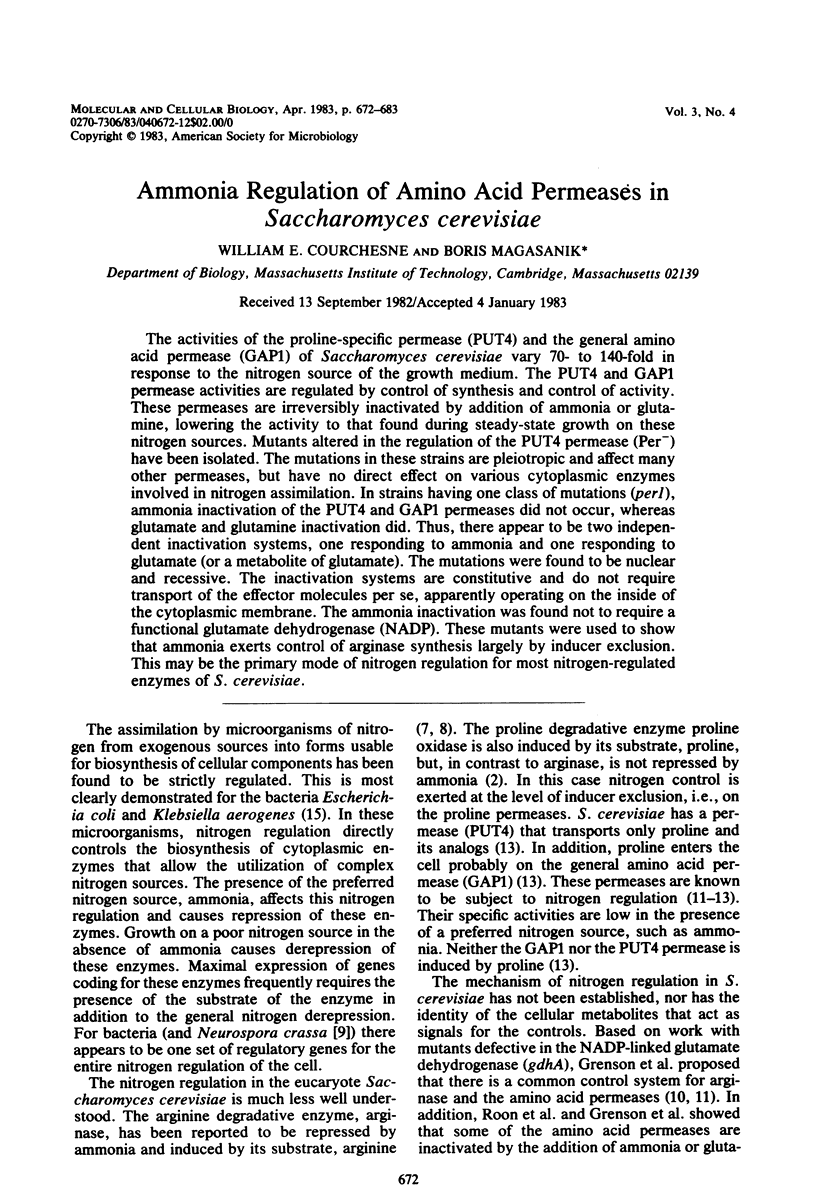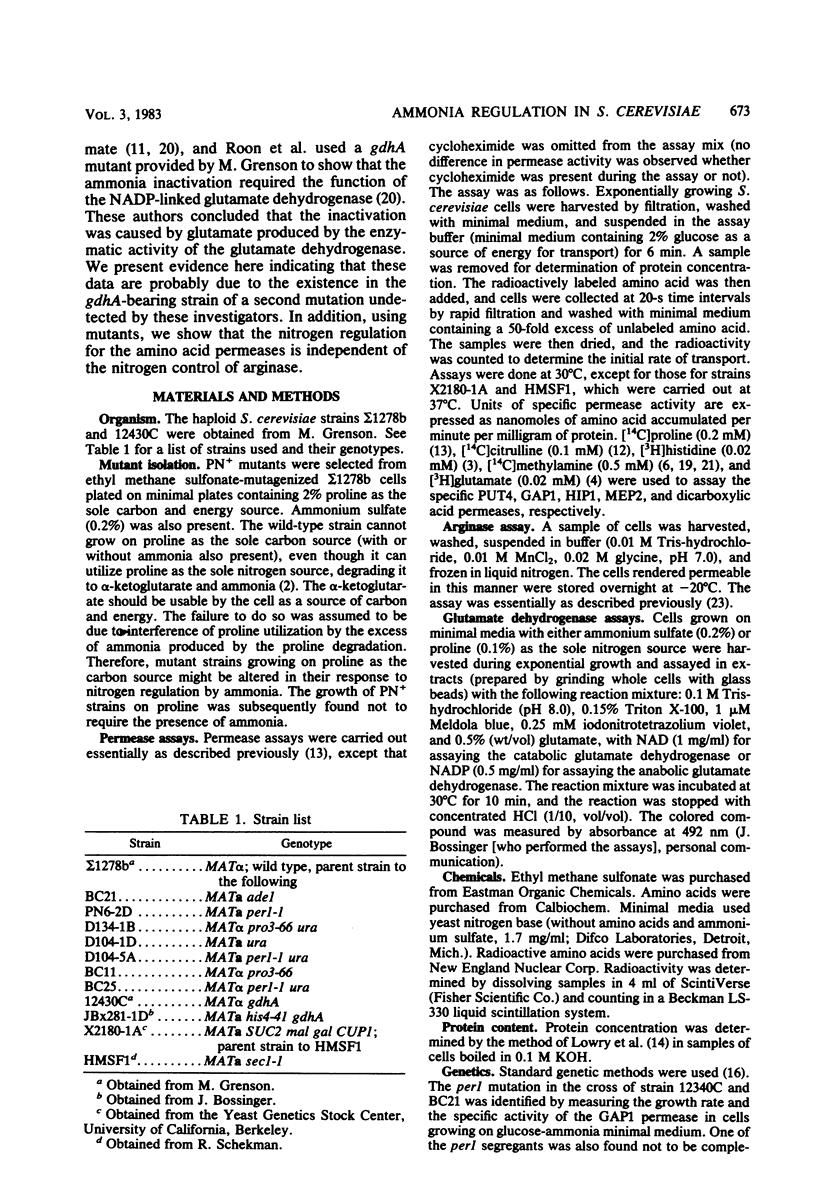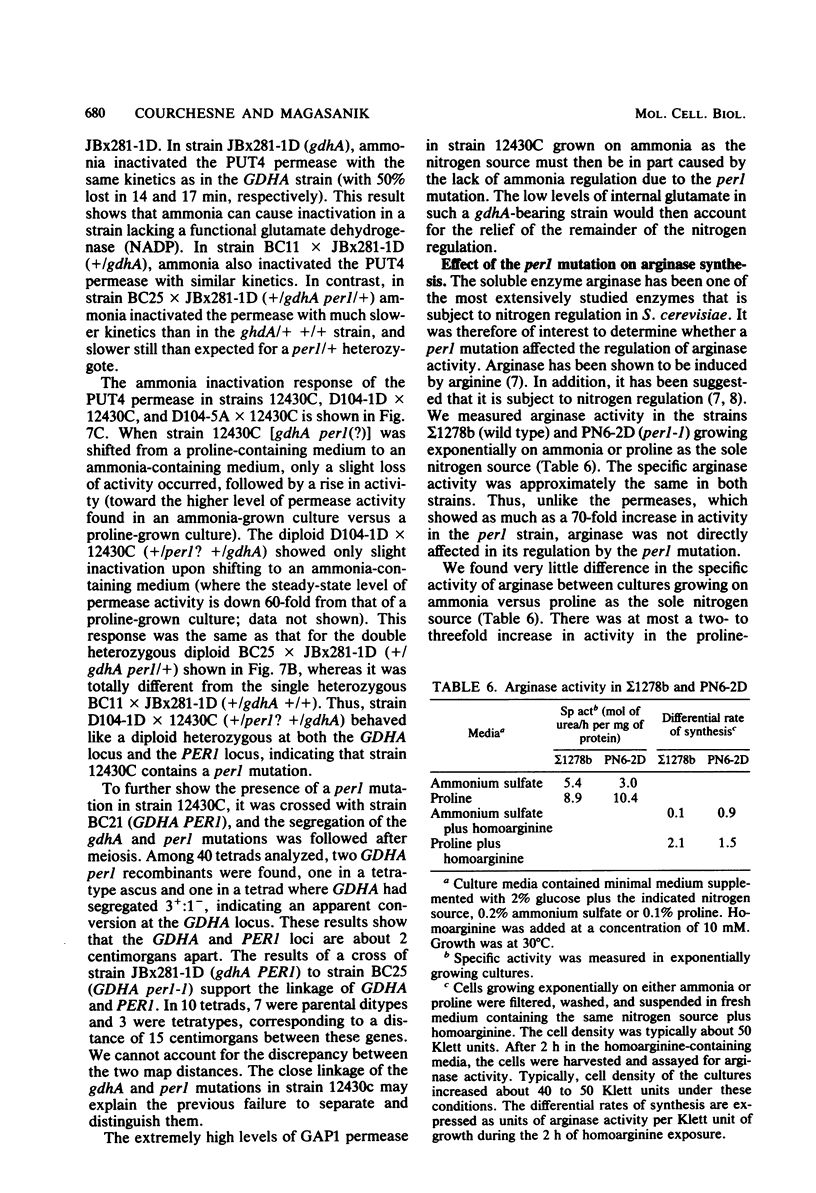Abstract
The activities of the proline-specific permease (PUT4) and the general amino acid permease (GAP1) of Saccharomyces cerevisiae vary 70- to 140-fold in response to the nitrogen source of the growth medium. The PUT4 and GAP1 permease activities are regulated by control of synthesis and control of activity. These permeases are irreversibly inactivated by addition of ammonia or glutamine, lowering the activity to that found during steady-state growth on these nitrogen sources. Mutants altered in the regulation of the PUT4 permease (Per-) have been isolated. The mutations in these strains are pleiotropic and affect many other permeases, but have no direct effect on various cytoplasmic enzymes involved in nitrogen assimilation. In strains having one class of mutations (per1), ammonia inactivation of the PUT4 and GAP1 permeases did not occur, whereas glutamate and glutamine inactivation did. Thus, there appear to be two independent inactivation systems, one responding to ammonia and one responding to glutamate (or a metabolite of glutamate). The mutations were found to be nuclear and recessive. The inactivation systems are constitutive and do not require transport of the effector molecules per se, apparently operating on the inside of the cytoplasmic membrane. The ammonia inactivation was found not to require a functional glutamate dehydrogenase (NADP). These mutants were used to show that ammonia exerts control of arginase synthesis largely by inducer exclusion. This may be the primary mode of nitrogen regulation for most nitrogen-regulated enzymes of S. cerevisiae.
Full text
PDF











Selected References
These references are in PubMed. This may not be the complete list of references from this article.
- Boehlke K. W., Friesen J. D. Cellular content of ribonucleic acid and protein in Saccharomyces cerevisiae as a function of exponential growth rate: calculation of the apparent peptide chain elongation rate. J Bacteriol. 1975 Feb;121(2):429–433. doi: 10.1128/jb.121.2.429-433.1975. [DOI] [PMC free article] [PubMed] [Google Scholar]
- Brandriss M. C., Magasanik B. Genetics and physiology of proline utilization in Saccharomyces cerevisiae: enzyme induction by proline. J Bacteriol. 1979 Nov;140(2):498–503. doi: 10.1128/jb.140.2.498-503.1979. [DOI] [PMC free article] [PubMed] [Google Scholar]
- Crabeel M., Grenson M. Regulation of histidine uptake by specific feedback inhibition of two histidine permeases in Saccharomyces cerevisiae. Eur J Biochem. 1970 May 1;14(1):197–204. doi: 10.1111/j.1432-1033.1970.tb00278.x. [DOI] [PubMed] [Google Scholar]
- Darte C., Grenson M. Evidence for three glutamic acid transporting systems with specialized physiological functions in Saccharomyces cerevisiae. Biochem Biophys Res Commun. 1975 Dec 1;67(3):1028–1033. doi: 10.1016/0006-291x(75)90777-9. [DOI] [PubMed] [Google Scholar]
- Deschamps J., Dubois E., Wiame J. M. L-Ornithine transaminase synthesis in Saccharomyces cerevisiae: regulation by inducer exclusion. Mol Gen Genet. 1979 Jul 24;174(3):225–232. doi: 10.1007/BF00267794. [DOI] [PubMed] [Google Scholar]
- Dubois E. L., Wiame J. M. Catabolic synergism: a cooperation between the availability of substrate and the need for nitrogen in the regulation of arginine catabolism in Saccharomyces cerevisiae. Mol Gen Genet. 1978 Sep 8;164(3):275–283. doi: 10.1007/BF00333157. [DOI] [PubMed] [Google Scholar]
- Dubois E., Grenson M. Methylamine/ammonia uptake systems in saocharomyces cerevisiae: multiplicity and regulation. Mol Gen Genet. 1979 Aug;175(1):67–76. doi: 10.1007/BF00267857. [DOI] [PubMed] [Google Scholar]
- Dubois E., Grenson M., Wiame J. M. The participation of the anabolic glutamate dehydrogenase in the nitrogen catabolite repression of arginase in Saccharomyces cerevisiae. Eur J Biochem. 1974 Oct 2;48(2):603–616. doi: 10.1111/j.1432-1033.1974.tb03803.x. [DOI] [PubMed] [Google Scholar]
- Facklam T. J., Marzluf G. A. Nitrogen regulation of amino acid catabolism in Neurospora crassa. Biochem Genet. 1978 Apr;16(3-4):343–354. doi: 10.1007/BF00484090. [DOI] [PubMed] [Google Scholar]
- Grenson M., Dubois E., Piotrowska M., Drillien R., Aigle M. Ammonia assimilation in Saccharomyces cerevisiae as mediated by the two glutamate dehydrogenases. Evidence for the gdhA locus being a structural gene for the NADP-dependent glutamate dehydrogenase. Mol Gen Genet. 1974;128(1):73–85. doi: 10.1007/BF00267295. [DOI] [PubMed] [Google Scholar]
- Grenson M., Hou C. Ammonia inhibition of the general amino acid permease and its suppression in NADPH-specific glutamate dehydrogenaseless mutants of saccharomyces cerevisiae. Biochem Biophys Res Commun. 1972 Aug 21;48(4):749–756. doi: 10.1016/0006-291x(72)90670-5. [DOI] [PubMed] [Google Scholar]
- Grenson M., Hou C., Crabeel M. Multiplicity of the amino acid permeases in Saccharomyces cerevisiae. IV. Evidence for a general amino acid permease. J Bacteriol. 1970 Sep;103(3):770–777. doi: 10.1128/jb.103.3.770-777.1970. [DOI] [PMC free article] [PubMed] [Google Scholar]
- LOWRY O. H., ROSEBROUGH N. J., FARR A. L., RANDALL R. J. Protein measurement with the Folin phenol reagent. J Biol Chem. 1951 Nov;193(1):265–275. [PubMed] [Google Scholar]
- Lasko P. F., Brandriss M. C. Proline transport in Saccharomyces cerevisiae. J Bacteriol. 1981 Oct;148(1):241–247. doi: 10.1128/jb.148.1.241-247.1981. [DOI] [PMC free article] [PubMed] [Google Scholar]
- Magasanik B. Genetic control of nitrogen assimilation in bacteria. Annu Rev Genet. 1982;16:135–168. doi: 10.1146/annurev.ge.16.120182.001031. [DOI] [PubMed] [Google Scholar]
- Novick P., Field C., Schekman R. Identification of 23 complementation groups required for post-translational events in the yeast secretory pathway. Cell. 1980 Aug;21(1):205–215. doi: 10.1016/0092-8674(80)90128-2. [DOI] [PubMed] [Google Scholar]
- Novick P., Schekman R. Secretion and cell-surface growth are blocked in a temperature-sensitive mutant of Saccharomyces cerevisiae. Proc Natl Acad Sci U S A. 1979 Apr;76(4):1858–1862. doi: 10.1073/pnas.76.4.1858. [DOI] [PMC free article] [PubMed] [Google Scholar]
- Roon R. J., Even H. L., Dunlop P., Larimore F. L. Methylamine and ammonia transport in Saccharomyces cerevisiae. J Bacteriol. 1975 May;122(2):502–509. doi: 10.1128/jb.122.2.502-509.1975. [DOI] [PMC free article] [PubMed] [Google Scholar]
- Roon R. J., Larimore F., Levy J. S. Inhibition of amino acid transport by ammonium ion in Saccharomyces cerevisiae. J Bacteriol. 1975 Oct;124(1):325–331. doi: 10.1128/jb.124.1.325-331.1975. [DOI] [PMC free article] [PubMed] [Google Scholar]
- Roon R. J., Levy J. S., Larimore F. Negative interactions between amino acid and methylamine/ammonia transport systems of Saccharomyces cerevisiae. J Biol Chem. 1977 Jun 10;252(11):3599–3604. [PubMed] [Google Scholar]
- Sumrada R., Cooper T. G. Basic amino acid inhibition of cell division and macromolecular synthesis in Saccharomyces cerevisiae. J Gen Microbiol. 1978 Sep;108(1):45–56. doi: 10.1099/00221287-108-1-45. [DOI] [PubMed] [Google Scholar]
- Whitney P. A., Magasanik B. The induction of arginase in Saccharomyces cerevisiae. J Biol Chem. 1973 Sep 10;248(17):6197–6202. [PubMed] [Google Scholar]
- Wiley W. R., Matchett W. H. Tryptophan transport in Neurospora crassa. II. Metabolic control. J Bacteriol. 1968 Mar;95(3):959–966. doi: 10.1128/jb.95.3.959-966.1968. [DOI] [PMC free article] [PubMed] [Google Scholar]


